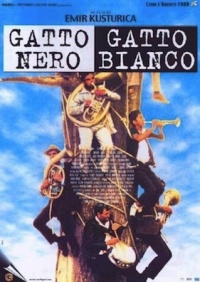Difference between revisions of "Black Cat, White Cat (1998)"
(Created page with "200px|thumbnail|left === A grotesque picture of Romanian culture === Shot in 3 different languages - Bulgarian, Serbian and Romani - Emi...") |
|||
| Line 1: | Line 1: | ||
[[File:1998 Black cat white cat.jpg|200px|thumbnail|left]] | [[File:1998 Black cat white cat.jpg|200px|thumbnail|left]] | ||
| − | === A | + | === A Grotesque Picture of Romanian Culture === |
Shot in 3 different languages - Bulgarian, Serbian and Romani - Emir, Kusturica’s Black Cat, White Cat is one of the best-known Romanian films. It shows, via colorful cuts and scenes enlivened by traditional Balkan music, what lies behind the stereotype of the ‘gipsies’, whose history and customs are often ignored. Due to the international acclaim it received, the movie served as a means of understanding and unveiling the mysteries of the most stigmatized culture in Europe, enchanting many people along the way. | Shot in 3 different languages - Bulgarian, Serbian and Romani - Emir, Kusturica’s Black Cat, White Cat is one of the best-known Romanian films. It shows, via colorful cuts and scenes enlivened by traditional Balkan music, what lies behind the stereotype of the ‘gipsies’, whose history and customs are often ignored. Due to the international acclaim it received, the movie served as a means of understanding and unveiling the mysteries of the most stigmatized culture in Europe, enchanting many people along the way. | ||
Revision as of 12:58, 23 October 2014
A Grotesque Picture of Romanian Culture
Shot in 3 different languages - Bulgarian, Serbian and Romani - Emir, Kusturica’s Black Cat, White Cat is one of the best-known Romanian films. It shows, via colorful cuts and scenes enlivened by traditional Balkan music, what lies behind the stereotype of the ‘gipsies’, whose history and customs are often ignored. Due to the international acclaim it received, the movie served as a means of understanding and unveiling the mysteries of the most stigmatized culture in Europe, enchanting many people along the way.
